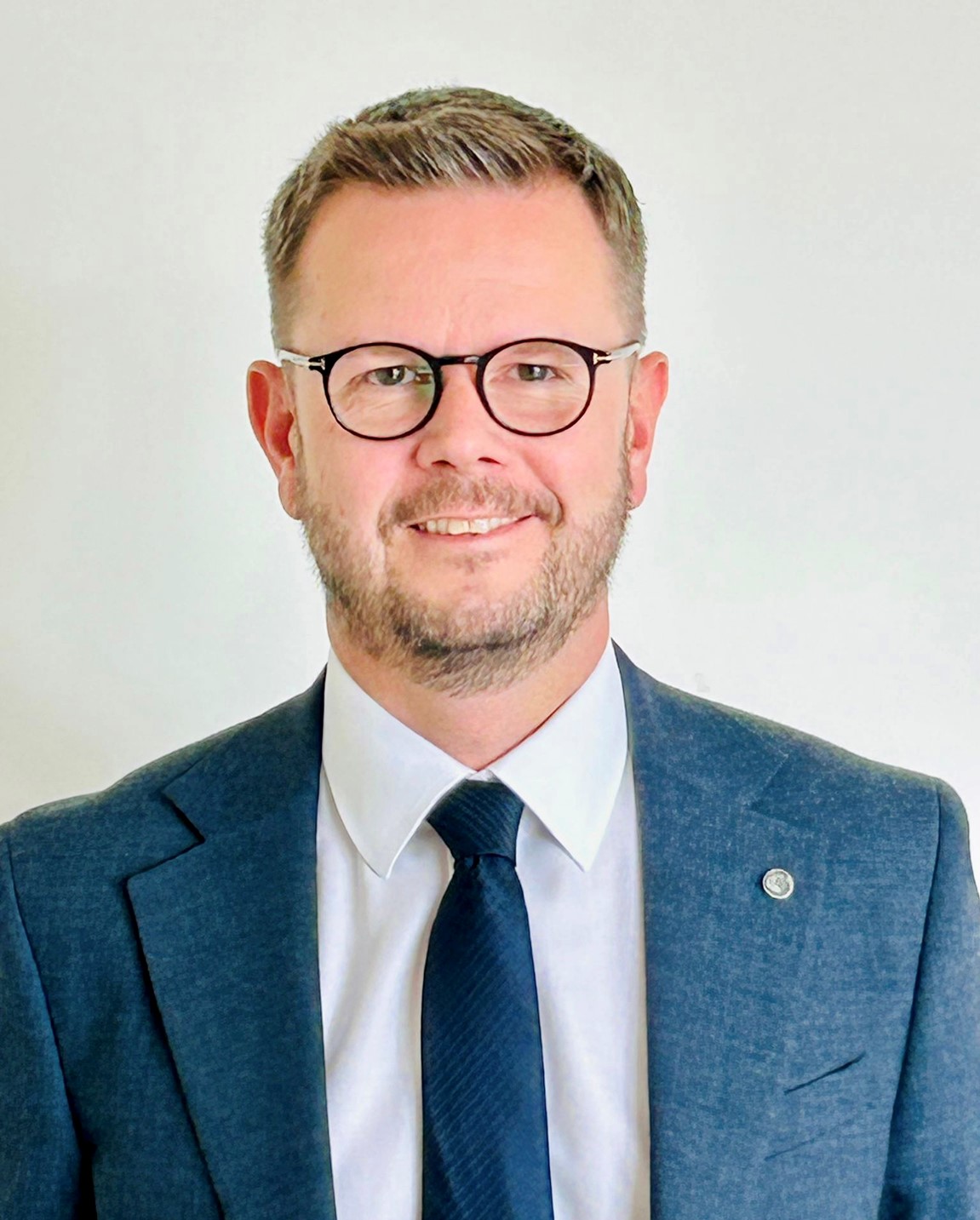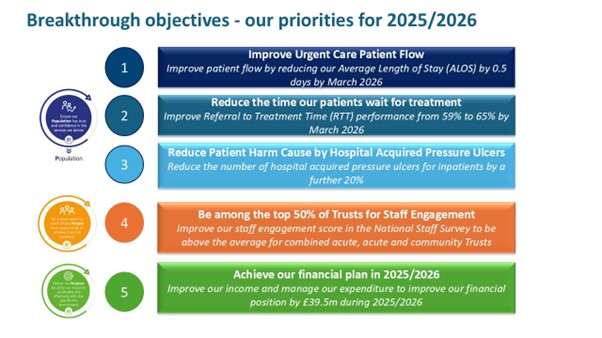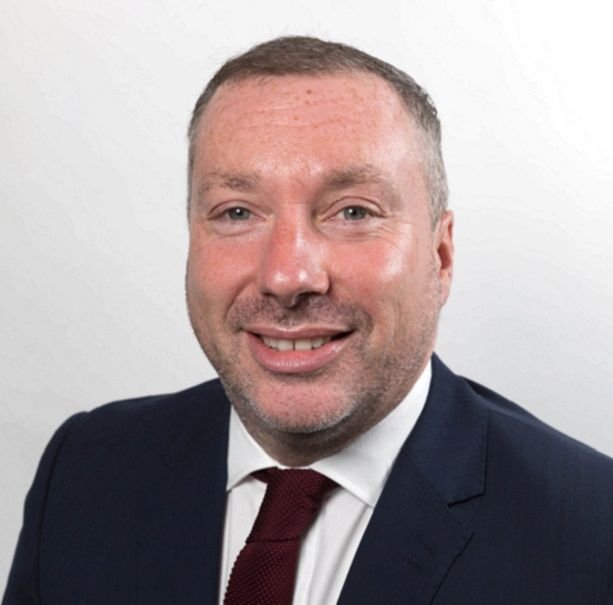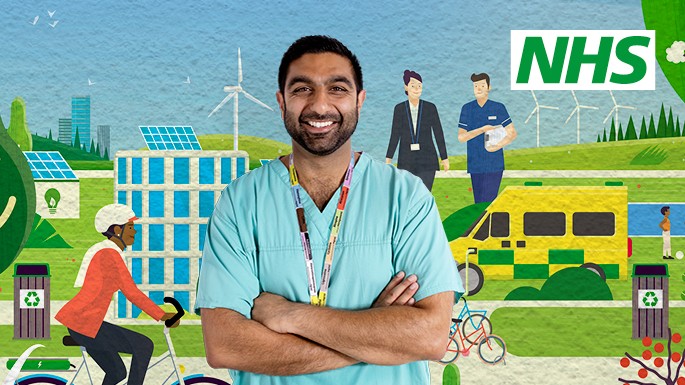Posted on: 19 September 2025
 Picture St Challenged Hospital tower. There’s a helicopter on the roof dropping piles of initiatives, policies, targets, data collection requirements. On the top floor, leaders and managers are running around trying to action all of these. With no connection to the next level of teams putting out fires here, there and everywhere, while trying to organise patient care. With no connection to the bottom level, where teams are doing their best to care for patients, with more and more coming in the doors and ambulances queuing outside. Sound familiar to anyone? We can’t pretend that we didn’t recognise some of that here at Mid Yorkshire.
Picture St Challenged Hospital tower. There’s a helicopter on the roof dropping piles of initiatives, policies, targets, data collection requirements. On the top floor, leaders and managers are running around trying to action all of these. With no connection to the next level of teams putting out fires here, there and everywhere, while trying to organise patient care. With no connection to the bottom level, where teams are doing their best to care for patients, with more and more coming in the doors and ambulances queuing outside. Sound familiar to anyone? We can’t pretend that we didn’t recognise some of that here at Mid Yorkshire.
I’ve heard it said that running a healthcare organisation is one of the most complex challenges there is, even more so than running big businesses or airports. It is easy in that complex environment - when the stakes are no less high than people’s health and futures – to end up trying to do everything and not being able to bring sufficient focus to the things that really make a difference.
This is one of the reasons why we have introduced Improving Together, which is a structured, proven approach to embedding continuous improvement into everyday work, so that teams feel empowered to make meaningful changes that improve patient care. That kind of statement will be familiar to those of you well-versed in the tools and techniques of improvement methodology. To the uninitiated, it might sound like the kind of grand statement that goes on a poster or in a strategy document. But does it actually change anything day to day?
Well, that’s the thing: we are determined that Improving Together is about creating a culture in which improving how we work is not an initiative or a project (though there will be plenty of those) but simply how we work every day.
Back in January our first two steps were to introduce training and development in Improving Together to the Executive leadership team, whilst at the same time starting model cells on nine wards across Pinderfields and Dewsbury. Through a combination of data collection, visual boards, daily improvement huddles and techniques like A3 thinking, the ward teams began by identifying their key drivers of patients’ length of stay (e.g. delays to discharge). This has been our focal point to start with because data tells us that reducing the length of stay of our patients where appropriate is the single most important thing we could do to improve long waits in our emergency departments and overcrowding on our wards.
Through this approach, the teams have been coming up with hundreds of improvement ideas – from small niggles to big cross-departmental changes. It may sound like a simple and obvious thing to do but in wards under extraordinary pressure, it’s not always easy to see the wood for the trees. This is evidence-based, data-driven change in action.
Of course, we can support change in the way our teams work but if the systems and governance around them doesn’t change, then neither will our culture. With that huge complexity we’ve already mentioned and the heavy regulatory environment in which we work, it’s not easy. But over the last few months we have distilled down our Trust strategy into strategic initiatives (the longer term, must-do Trust-wide programmes of work) and our annual breakthrough objectives (the things that, if we achieve them, will have the biggest impact).

Breakthrough Objectives - our priorities for 2025/2026
-
Improve Urgent Care Patient Flow - Improve patient flow by reducing our Average Length of Stay (ALOS) by 0.5 days by March 2026.
-
Reduce the time our patients wait for treatment - Improve Referral to Treatment Time (RTT) performance from 59% to 65% by March 2026.
-
Reduce Patient Harm Caused by Hospital Acquired Pressure Ulcers - Reduce the number of hospital acquired pressure ulcers for inpatients by a further 20%.
-
Be among the top 50% of Trusts for Staff Engagement - Improve our staff engagement score in the National Staff Survey to be above the average for combined acute, acute, and community Trusts.
-
Achieve our financial plan in 2025/2026 - Improve our income and manage our expenditure to improve our financial position by £39.5m during 2025/2026.
We are also in the process of prioritising the 300 plus Trust projects we had into a more manageable number aligned with our strategic initiatives and breakthroughs. This all then feeds into the objectives of divisions, departments and teams. It is in this way we are creating a golden thread between our strategy and our daily work so that everyone in the organisation is working to the same goals. The theory is that teams working together to the same goal can achieve great things. But 10,000 staff all working to the same goals can transform things.
It's still early days but so far there are positive signs. The length of stay of our patients in July this year is more than half a day shorter than it was this same time last year. Our use of temporary escalation spaces has much reduced compared to the same period last year, as have our 12-hour breaches for admissions. Winter will no doubt be a significant test though.
However, it’s about more than just the stats. I go onto the model cell wards and there is a buzz about the place. Staff are feeling free to get on and ‘do’ rather than feeling tied up in bureaucracy. Leaders and managers are starting to articulate their challenges and actions differently. And teams outside of the model cells are asking what it’s all about and wanting to get involved.
This is a multi-year programme, so we are under no illusions: there is a long way to go, and we are learning all the time, but we are enthused and keen to share that enthusiasm with others. We are by no means alone in introducing Improving Together. Harrogate are ahead of us on the journey as are others up and down the country. My hope is that as we get further on, it will not only ensure we are creating the best environment in which our talented and hardworking staff can thrive for the benefit of our patients, but it will also further support us in our role as partner within our healthcare system.
If you’d like to know more, feel free to contact us at midyorks.
Thank you for reading,
Chris
What's been happening this week?
 Trust leadership changes
Trust leadership changes
Brendan Brown, Chief Executive at Calderdale and Huddersfield Foundation Trust (CHFT), is taking over from Professor Phil Wood as CEO of Leeds Teaching Hospitals Trust on a six to 12 month secondment. Deputy Chief Executive Rob Aitchison will take over from Brendan at CHFT.
We thank Phil for his years of leadership, not just in Leeds, but across the whole West Yorkshire health and care system, and we wish Brendan and Rob all the very best in their new roles.
West Yorkshire trusts confirmed as part of national maternity investigation
Bradford Teaching Hospitals NHS Foundation Trust and Leeds Teaching Hospitals NHS Trust have been announced as among the 14 hospital trusts in England to be looked at as part of a rapid, independent, national investigation into maternity and neonatal services, led by Baroness Amos. Find out more in this article from the Department for Health and Social Care.
Mid Yorkshire secures £5m to accelerate net zero goals
 Mid Yorkshire Teaching NHS Trust has been awarded a £5 million government grant to supercharge its carbon reduction efforts and drive forward its commitment to achieving net zero.
Mid Yorkshire Teaching NHS Trust has been awarded a £5 million government grant to supercharge its carbon reduction efforts and drive forward its commitment to achieving net zero.
The funding, secured through phase 4 of the Public Sector Decarbonisation Scheme, will enable the Trust to implement cutting-edge energy-saving technologies across its estate. Key projects include major decarbonisation works at Pontefract Hospital’s main building and the pathology building at Pinderfields Hospital in Wakefield. Find out more on the Trust website.

